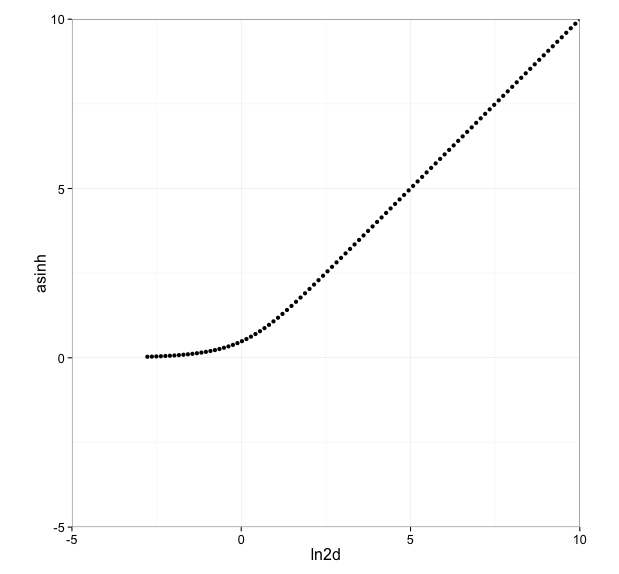Inverse hyperbolic sine transformation for ggplot2 using scales
March 8, 2013The inverse hyperbolic sin (asinh in R) is defined as
\[asinh = ln(x + \sqrt{1 + x^2})\]
Is a transformation that is asymptotically identical to \(ln(2x)\) for
large x, but still defined for 0 and negative values. This makes it a
good transformation for the count data we often encounter (and which
often includes 0 counts).

For convenient plotting with ggplot2, here is a transformation that can be used in scale_continuous functions, along with some test cases for picking reasonable breaks for the axes.
library(scales)
library(testthat)
asinh_breaks <- function(x) {
br <- function(r) {
lmin <- round(log10(r[1]))
lmax <- round(log10(r[2]))
lbreaks <- seq(lmin, lmax, by = 1)
breaks <- 10 ^ lbreaks
}
p.rng <- range(x[x > 0], na.rm = TRUE)
breaks <- br(p.rng)
if (min(x) <= 0) {breaks <- c(0, breaks)}
if (sum(x < 0) > 1) { #more negative values that expected from expanding scale that includes zero
n.rng <- -range(x[x < 0], na.rm = TRUE)
breaks <- c(breaks, -br(n.rng))
}
return(sort(breaks))
}
test_that("asinh_breaks make sense", {
expect_equal(asinh_breaks(c(-0.05, 0, 1, 101)), c(0, 1, 10, 100))
expect_equal(asinh_breaks(c(-0.11, -0.05, 0, 1, 101)), c(-0.1, 0, 1, 10, 100))
expect_equal(asinh_breaks(c(0, 10, 1001)), c(0, 10, 100, 1000))
expect_equal(asinh_breaks(c(0, 0.05, 0.07, 0.1, 0.2)), c(0, 0.1))
expect_equal(asinh_breaks(c(0.01, 0.02)), c(0.01))
})
asinh_trans <- function() {
trans_new("asinh",
transform = asinh,
inverse = sinh,
breaks = asinh_breaks)
}